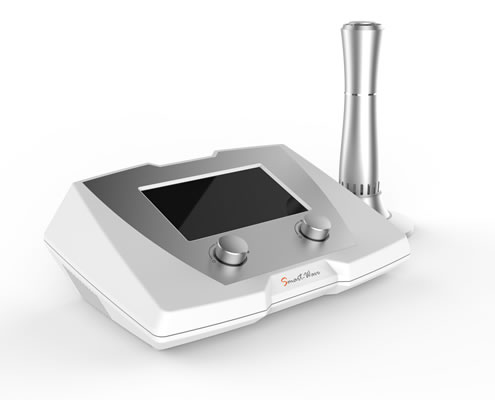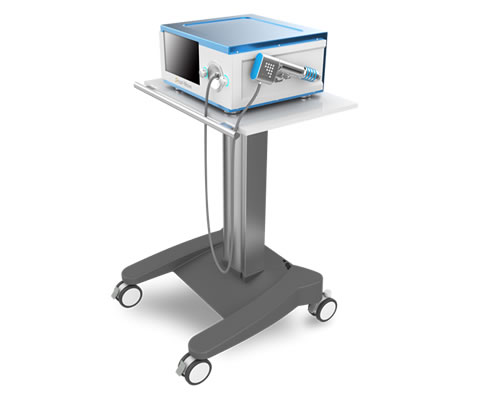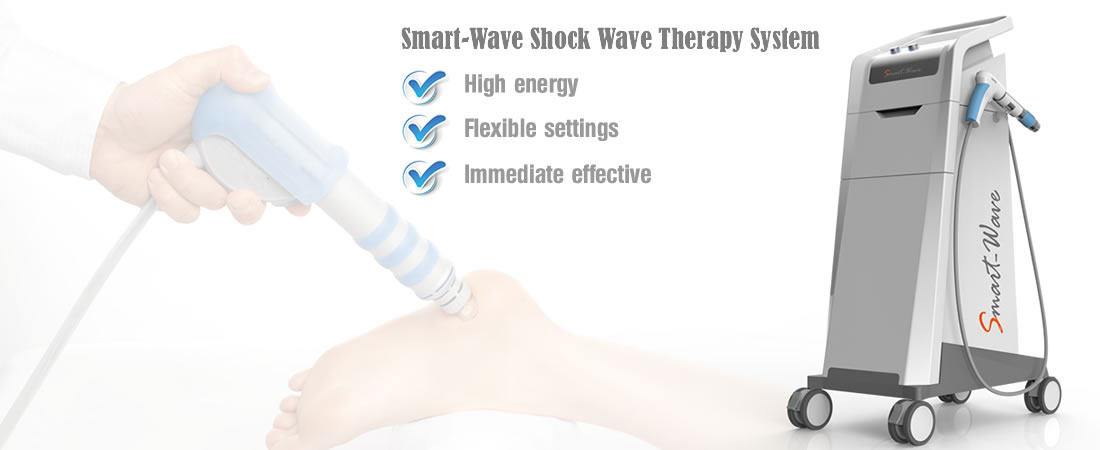Plantar Fasciitis
Plantar fasciitis (PLAN-tur fas-e-I-tis) is one of the most common causes of heel pain. It involves inflammation of a thick band of tissue that runs across the bottom of your foot and connects your heel bone to your toes (plantar fascia). Plantar fasciitis commonly causes stabbing pain that usually occurs with your first steps in the morning. As you get up and move more, the pain normally decreases, but it might return after long periods of standing or after rising from sitting. Plantar fasciitis is more common in runners. In addition, people who are overweight and those who wear shoes with inadequate support have an increased risk of plantar fasciitis. (from mayoclinic)
- Heel pain
- Foot pain
- Stiffness
- Tenderness
Shock wave therapy machine for plantar fasciitis
ExtraCorporeal Shockwave Therapy is a noninvasive method that uses pressure waves to treat various musculoskeletal conditions. High-energy acoustic waves (shock waves) deliver a mechanical force to the body’s tissues.
The plantar fascia is a thick connective tissue structure extending over the underside of the foot. The fibres of the plantar fascia are orientated along the length of its structure, which is an important aspect to consider when understanding the mechanics of how the foot works and how plantar fasciitis occurs. The plantar fascia can be split into 3 portions, which are the medial portion, central (largest and most prominent) and lateral portions. An interesting point is that the plantar fascia in younger people has a direct fascial connection with the Achilles tendon, this becomes thinner with age and reduces to have no communicating fibres in more senior people. The Achilles and plantar fascia also have separate insertion points directly into the calcaneus. Plantar fasciitis is a very painful condition where your heel may hurt, feel hot or swell. The pain is a result of inflammation or microscopic tears of the plantar fascia. The fascia is a thin layer of tough tissue supporting the arch of the foot. Sometimes people refer to plantar fasciitis as “heel spurs,” but this is not generally accurate, since the heel spurs are a result of plantar fasciitis. Heel spurs are a calcification which forms due to the damage to the fascia. Often when you have plantar fasciitis, the pain is at its most intense when you first get out of bed. Sometimes it is noticeable at the beginning of an activity and then gets better as the body warms up. Prolonged standing may cause pain, as well. Severe plantar fasciitis pain can cause loss of time from work and may lead to partial or total disability. Common surgical procedures used for the treatment of chronic plantar fasciitis may also lead to permanent disability. Plantar fasciitis was a frustrating condition for people who had this diagnosis. The old treatment paradigm relied on conservative therapy for an extended period. This treatment strategy includes rest, shoe inserts, stretching of the calf muscles, and a glucocorticoid injections for temporary relief. If these treatment modalities did not improve symptoms after six months to a year of treatment, then surgery was someone’s only definitive therapy.
Plantar fasciitis is the abnormal inflammation of the plantar fascia tissue on the under side of the foot. The insertion point to the calcaneus is the main focus of this. The main causes of mechanical plantar fasciitis are related to poor control of the foot during weight bearing. Prolonged over pronation can result in irritation to the plantar fascia. People suffering with over pronation issues generally speaking have a much more mobile foot type, which also tends to have a lower medial longitudinal arch. However, that is not to say that the pes cavus or high arched foot type will not pronate. The tibialis posterior muscle has been shown to be heavily involved with the control of arch height during weight bearing. The muscle is loaded eccentrically and needs to be strong and neurally geared towards controlling the effects of load on the arch height. Exercises are often directed at this muscle to help activate it more and correct faulty firing patterns. The net effect of this is the reduction of stress placed on the plantar fascia during weight bearing, with a proper functioning muscle. Controlling pronation is therefore key in this particular foot type. Plantar fasciitis may also occur in the high arched foot and results from the inability to dissipate force. The calcaneus and metatarsal heads are much closer together, the tarsal bones have less intra-osseous mobility and the first ray is often held in plantar flexion, which lead to a foot which is great at force transmission but exceptionally poor at shock absorbing.
Shockwave therapy for plantar fasciitis and heel pain is applied following a set protocol. This aids the transmission of the impulses into the desired area. The probe will then be placed over the desired area and then treatment for your plantar fasciitis and heel pain will begin. At first the clinician will ensure the discomfort is kept to a minimum. After a while as the impulses increase little pain is felt. Generally most applications of shockwave for plantar fasciitis and heel pain and most conditions will resolve within 3-4 sessions of 30 minutes (roughly). This obviously can depend on the exact presentation of the condition. Making sure you see someone quickly to have the condition diagnosed can reduce the number of sessions needed. It is vital that you continue to work with a physical therapist to maintain the exercise regime you should already be carrying out for plantar fasciitis and heel pain, prior to consulting for shockwave treatment. This will involve balancing exercises, strength exercises and a good eccentric loading programme depending on your stage of plantar fasciitis and heel pain.

Model: BS-SWT2X / BS-SWTX
Smallest shock wave machine, with single or dual channel output by seperate applicators. As many as 38 or more customized protocols, easy to use.

Model: BS-SWT5000
Extracorporeal shockwave therapy system, air compressor inside, pulse energy up to 5Bar and adjustable per 0.1Bar, frequency up to 22Hz, adjustable per 1Hz.

Model: BS-SWT6000
Full dimension shock wave machine, high energy, output pressure is more stable in long time operation. With trolley it is more easy to move.



